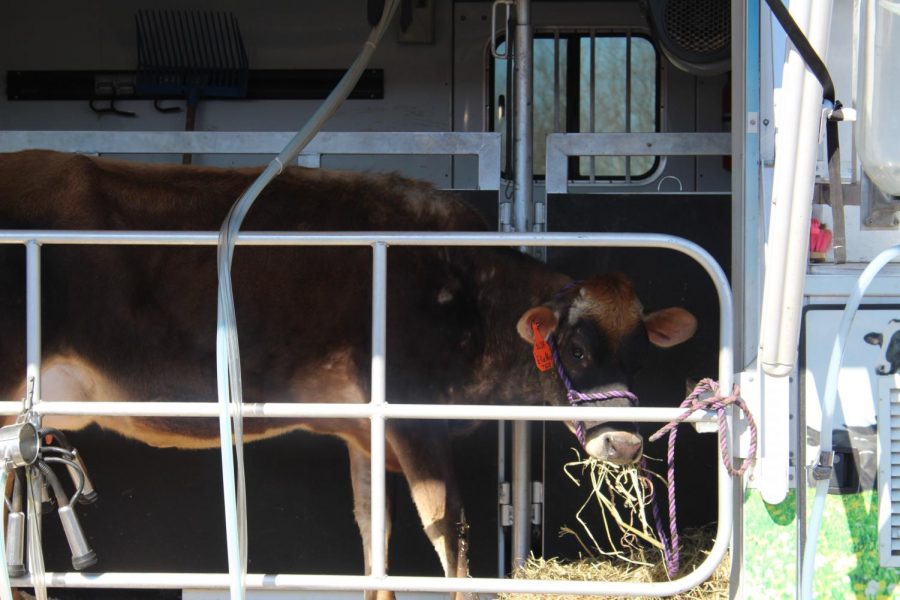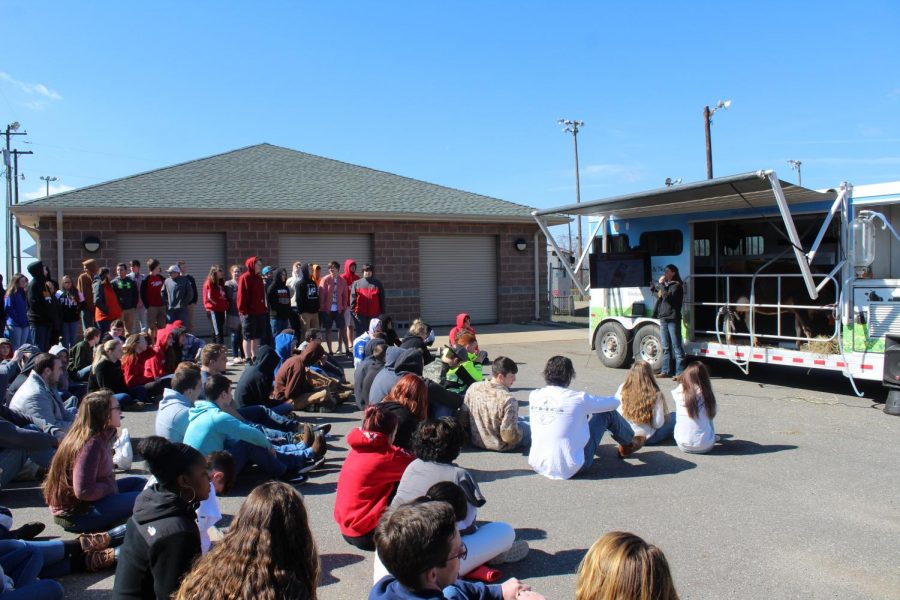Mobile Dairy Classroom (moo)ving to different schools
On Mar. 9, the agriculture classes held a Mobile Dairy Classroom. This is the first time the school had this kind of presentation available to students, allowing them to witness firsthand the way dairy farmers handle cattle and how dairy products are made. This was also opened to middle school agriculture students in Mrs. Carole Brown’s class, who were equally excited about getting to experience the Mobile Dairy Classroom. Along for the ride was Jersey cow, Ellie May, who was used to demonstrate the milking process cows go through.
Speaker Amanda Griffith began the presentation with a walk through of how much dairy is consumed on a day-to-day basis. Beginning with breakfast, and all the way until dinner, humans consume several types of dairy based food, such as milk, cheese, yogurt, and ice cream. Dairy (milk) makes up 16% of a person’s daily protein intake, including potassium and magnesium consumption.
This brought attention to the way people underestimate the dairy production process. The goal of the dairy classroom was to educate students about said process, beginning with the cow and ending up on the store shelves. Many students were surprised to learn that dairy farmers only make around $12 per 100 lbs of milk. Most dairy farmers also break around $16/cwt, so for prices to be along the lines of $12/cwt, it has become difficult for small dairy farms to stay in business.
As Griffith began to speak on the anatomy/importance of a cow in the dairy process, many students openly and confidently responded to her questions. Ms. Morgan Odom was happily surprised to see her students positively react to the presentation.
“They [students] are able to use a lot of the information they’re learning in the classroom and apply it to real life. We’ve learned about the digestive system of cattle, and I think the students enjoyed being able to see it first hand on an actual cow. Being around cattle is something some students don’t have the opportunity to do outside of school. My students definitely enjoy more hands-on learning like this because it keeps them engaged,” said Odom.
This presentation was also available to students in all CTE classes, so they could see all of the elective options they have to choose from. Not only does it bring more awareness to the agriculture industry, but it gives students the opportunity to discover if it is something they are interested in. This can also lead students to get involved with clubs like Future Farmers of America (FFA).
Students were also introduced to 2 ½ year old Ellie May, the Jersey Cow. She only makes milk for 10 months, typically giving 4-8 gallons of milk every day, equalling to 65 lbs of milk a day. Cows are bred every year to be able to produce milk, and repeat the process after the 10 month marking period when she dries out. She walked through the anatomy of the cow, naming off each body part and connecting it back to the way it aids in producing milk. Interestingly enough, happy cows are also proven to produce more milk. Griffith continuously made the point that it is important to responsibly handle the upkeep of healthy cows, both physically and emotionally.
“If we take good care of our cows, they’ll take good care of us,” said Griffith.
The students showed clear anticipation as the milking demonstration was about to be displayed. Griffith explained that the cow’s udders had to be cleaned with Betadine, a substance used to prevent the risk of infection and contamination of the milk. Griffith reassured students that the cow does not mind being milk because they carry that weight of the milk with them. The milk is pumped into a measuring container to keep track with how much is collected.
The technological advancements in the dairy industry also has sped up the process of milking. Griffith quickly demonstrated milking by hand to show how lengthy the process can be. Griffith explained that milking today is mostly handled by machines, getting the job done in roughly 7 minutes. When the process was finished, she asked the students if milk can be consumed directly from the cow. She responded by noting that, technically, a person can consume that milk if they own the cow and are aware of the welfare of their cow. However, in the state of Virginia, the milk is legally required to be pasteurized before it is sent out to the public. The milk is immediately chilled to keep it from souring, and then it is transported to processing plants where the milk it is heated to kill all of the bacteria. It takes roughly two days for the milk to get to a person’s dinner table.
Sophomore Peyton Criswell showed a deeper understanding of the dairy process after the Mobile Dairy Classroom.
“I was very excited for the presentation. It was a good opportunity for me at school. I didn’t know that it was possible to drink the milk straight from the cow, which is pretty cool,” said Criswell.
Criswell also pointed out that, in class, he had been learning about animals prior to the presentation, which helped in the understanding of how the cows were handled.
Odom commented on the attitude of all the students and said, “It makes me feel good that students enjoyed the presentation. They can learn about different farm animals in the classroom, but it’s important that they’re able to apply that knowledge while being around those animals in person.”
Your donation will support the student journalists of Tunstall High School. Your contribution will allow us to purchase equipment and cover our annual website hosting costs.

Brenda Arellano is a senior at Tunstall High School. This is her second year with the Trojan Messenger, returning from her freshman year to end her high...














